CeoTronics CT-DECTCASEGSM CT-DECT Case with GSM User Manual dok1267 be
CeoTronics AG CT-DECT Case with GSM dok1267 be
User Manual
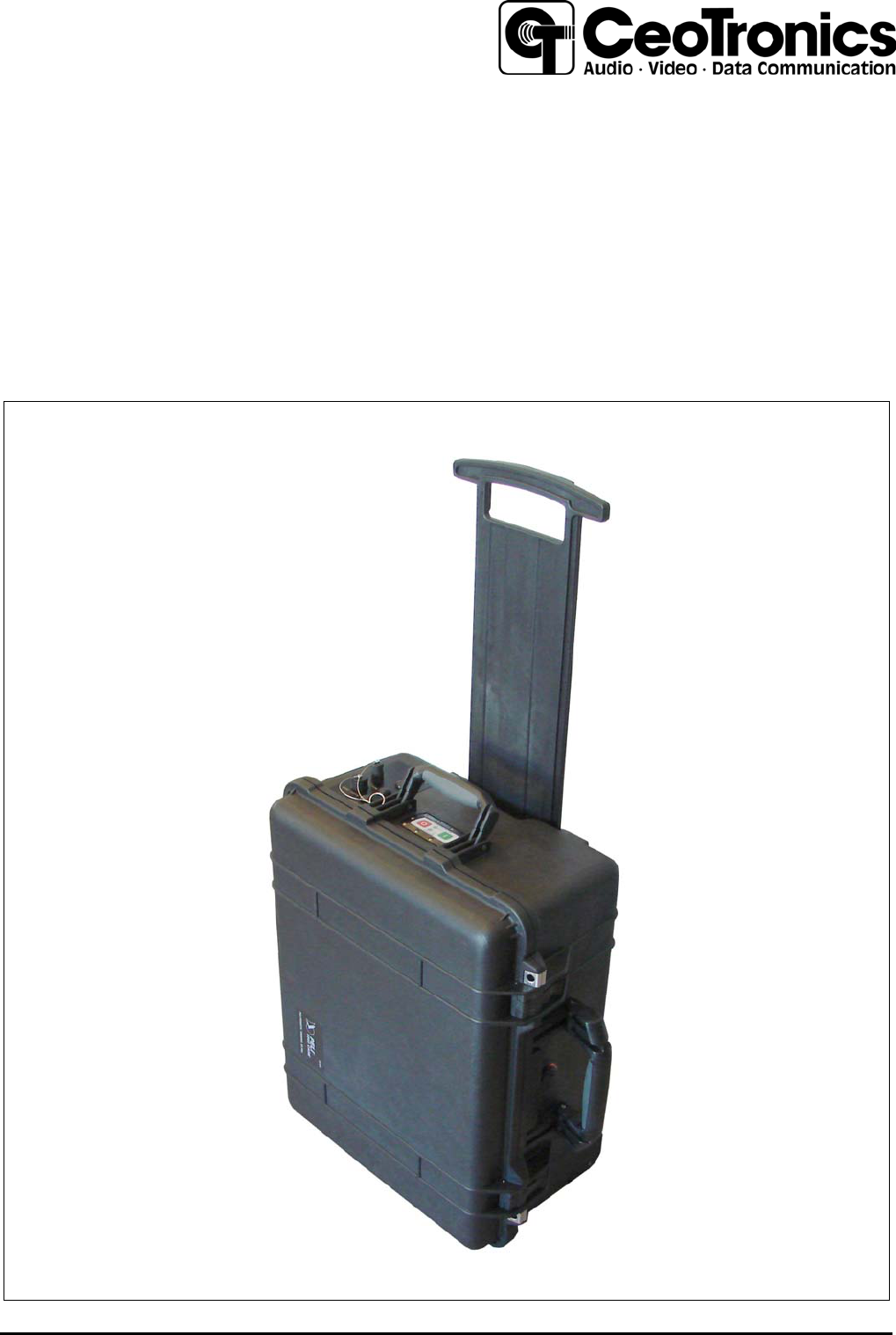
CT-DECT Case with GSM
and Radio communication
Description and Operation
CT-DECT Case

2
Contents
1. Important safety instructions ..............................................................................................................4
2. Description .........................................................................................................................................5
2.1 Purpose ......................................................................................................................................5
2.2 Overview CT-DECT Case...........................................................................................................7
2.3 Description..................................................................................................................................9
3. Commissioning and operation .........................................................................................................10
3.1 Connection of the CT-DECT Case............................................................................................10
3.2 Switching on, automatic connection setup, adjusting the speaker volume...............................10
3.3 Duplex – communication...........................................................................................................10
3.4 Radio – communication ............................................................................................................10
3.5 GSM – Communication.............................................................................................................11
3.6 Battery under voltage warning CT-DECT Case........................................................................11
4. Safekeeping – storage .....................................................................................................................11
5. Charging and changing Power Supply with the Li-Ion battery 3.6 V/6 Ah......................................12
5.1 General .....................................................................................................................................12
5.2 Changing the Power Supply of the CT-DECT Case .................................................................13
6. Maintenance ....................................................................................................................................13
6.1 Visual inspections .....................................................................................................................13
6.2 Cleaning....................................................................................................................................13
7. Installation and Uninstallation of the components CT-DECT Interface, GSM-phone and Two-way
radio .................................................................................................................................................14
7.1 CT-DECT Interface ...................................................................................................................14
7.2 GSM-phone ..............................................................................................................................14
7.3 Two-way radio ..........................................................................................................................14
8. On-air subscription of CT-DECT Case and CT-DECT Multi Standard...........................................15
8.1 General .....................................................................................................................................15
8.2 Principle of subscription............................................................................................................15
8.3 On-air subscription....................................................................................................................16
8.4 On-air subscription CT-DECT devices standard of pair 1.........................................................17
9. Technical Specifications ..................................................................................................................18
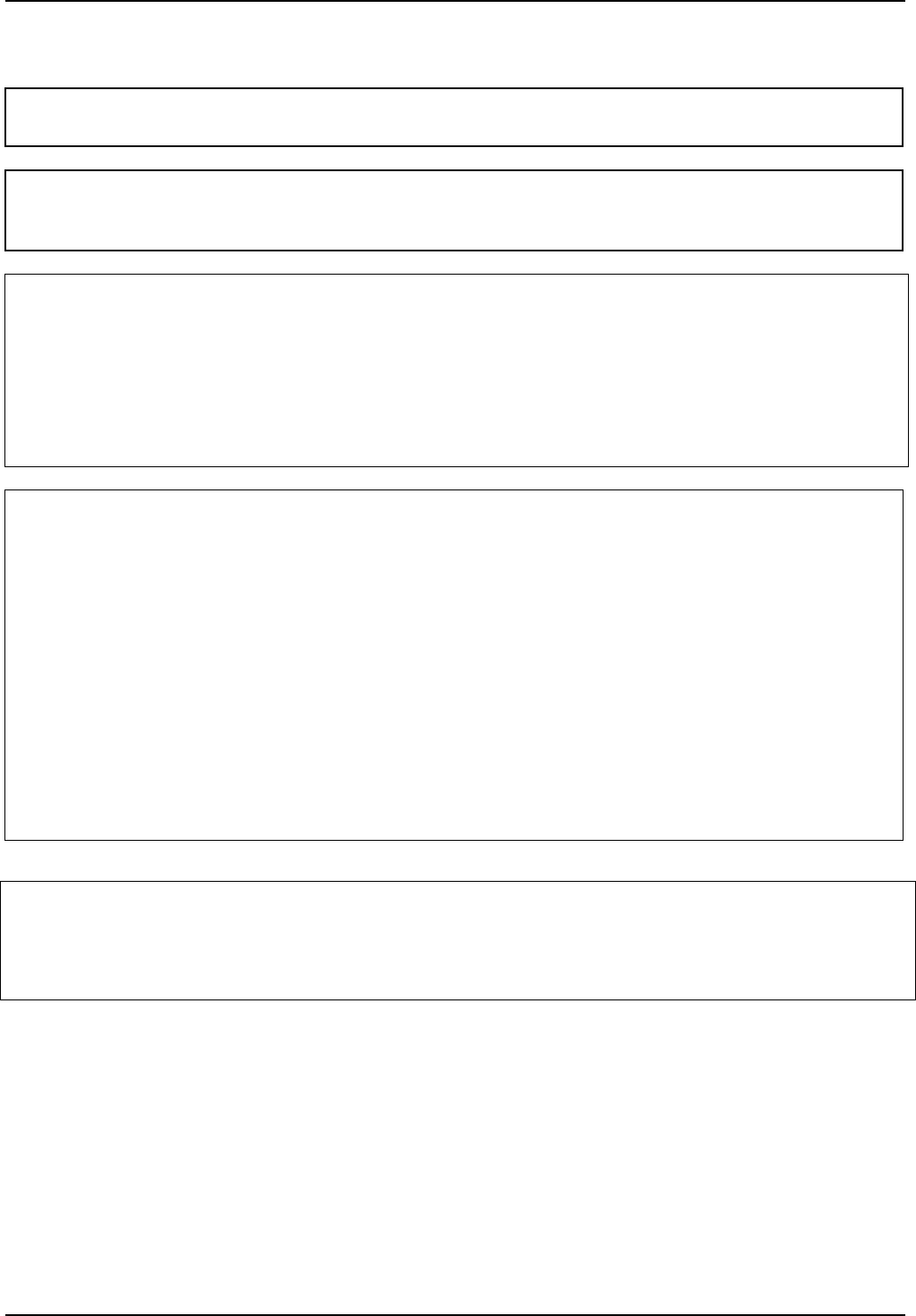
3
Important Notes for operation of the CT-DECT System in the USA
Please note that any changes or modifications not expressly approved by the party
responsible for compliance will void the user’s authority to operate the equipment.
This device complies with part 15 of the FCC Rules. Operation is subject to the following two
conditions: (1) This device may not cause harmful interference, and (2) this device must
accept any interference received, including interference that may cause undesired operation.
Note: This equipment has been tested and found to comply with the limits for a Class A digital
device, pursuant to part 15 of the FCC Rules. These limits are designed to provide reasonable
protection against harmful interference when the equipment is operated in a commercial envi-
ronment. This equipment generates, uses, and can radiate radio frequency energy and, if not
installed and used in accordance with the instruction manual, may cause harmful interference
to radio communications. Operation of this equipment in a residential area is likely to cause
harmful interference in which case the user will be required to correct the interference at his
own expense.
NOTE: This equipment has been tested and found to comply with the limits for a Class B
digital device, pursuant to Part 15 of the FCC Rules. These limits are designed to provide
reasonable protection against harmful interference in a residential installation. This equip-
ment
generates, uses and can radiate radio frequency energy and, if not installed and used in
accordance with the instructions, may cause harmful interference to radio communications.
However, there is no guarantee that interference will not occur in a particular installation. If
this equipment does cause harmful interference to radio or television reception, which can be
determined by turning the equipment off and on, the user is encouraged to try to correct the
interference by one or more of the following measures:
. Reorient or relocate the receiving antenna.
. Increase the separation between the equipment and receiver.
. Connect the equipment into an outlet on a circuit different from that to which the receiver is
connected.
. Consult the dealer or an experienced radio/TV technician for help.
This equipment complies with FCC RF radiation exposure limits set forth for an uncontrolled
environment.To comply with FCC RF exposure compliance requirements, the antenna used for
this transmitter must be installed to provide a separation distance of at least 20 cm from all per-
sons and must not be co-located or operating in conjunction with any other antenna or transmit-
ter.
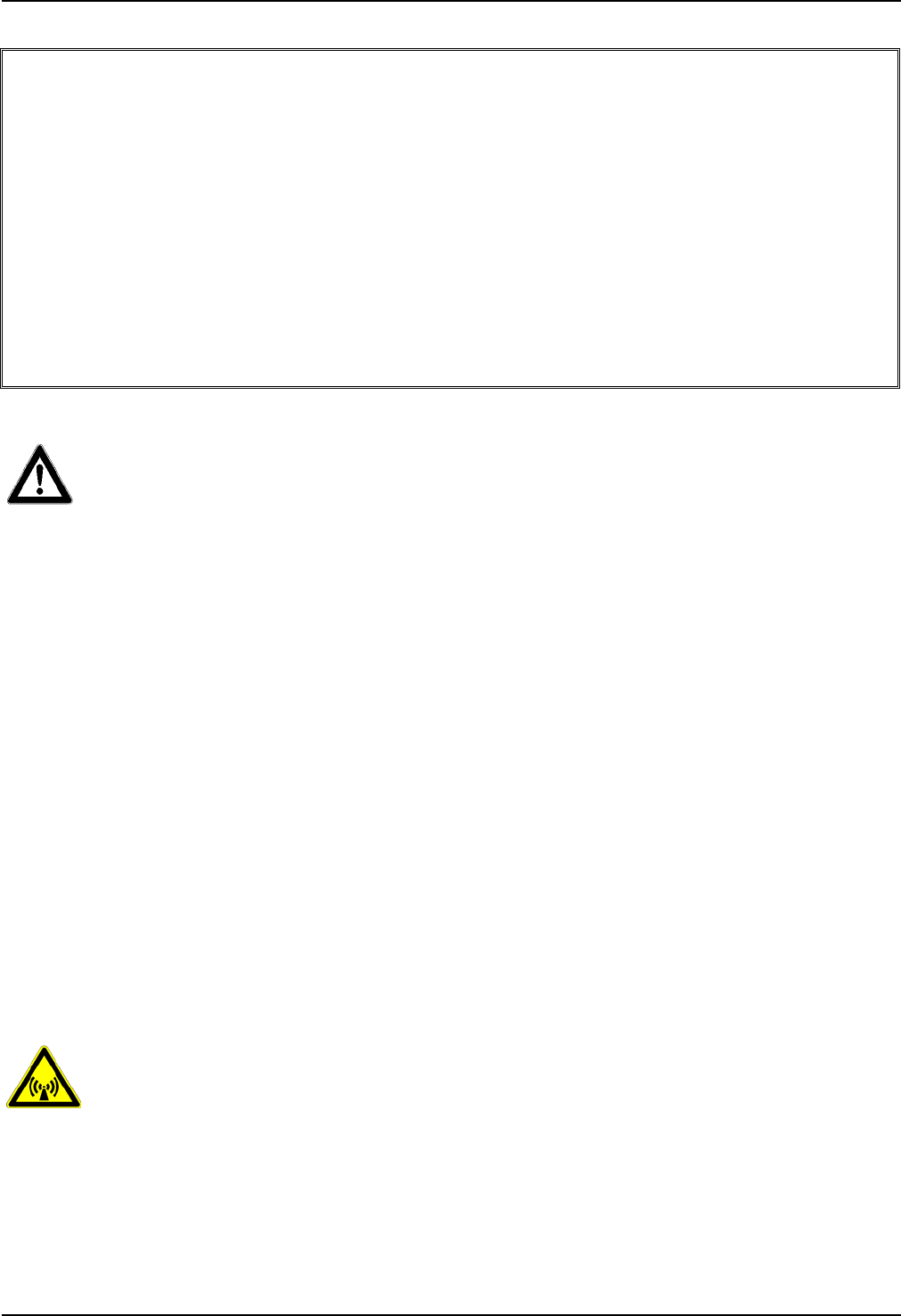
4
Important Information for Users of the
CT-DECT transceivers
CT-DECT transceivers that are not intrinsically safe (explosion-protected) and therefore do
not have any special hazardous duty marking must never be used in potentially explosive
atmospheres. Unprotected CT-DECT transceivers can trigger explosions unintentionally in
these areas.
CeoTronics does not assume any liability for damage to property and personal injuries of any
kind that can arise through the above mentioned or any other incorrect use of the CT-DECT
transceivers.
1. Important safety instructions
For the use of the device notice the national safety and accident prevention regula-
tions and the following safety instructions shown in italics in this instruction manual.
z Before using CeoTronics products read completely the appropriate operating instructions. If in
doubt, ask our technical staff.
z If repair work of any kind needs to be done to CeoTronics products, arrange for it to be performed
only by the company CeoTronics or by a specialized workshop that is authorized by CeoTronics.
In all other cases our warranty and liability for the product shall lapse.
z If products are operated on a mains voltage, always pull the mains plug out of the mains plug so-
cket before opening such products (e.g. for servicing purposes)!
z Do not store CeoTronics products outside or in damp ambient conditions. At all times keep them
clean, dry and at normal air humidity. CeoTronics products must not be stored in areas with a
temperature of over +80° C (+176° F), e.g. in the summertime on the parcel shelf of a car. If not
stated otherwise, the following temperature ranges are allowed for CeoTronics products: -10 to
+55° C (+14 to +131° F) for operation, -40 to +80° C (-40 to +176° F) for storage.
z Do not immerse a CeoTronics product into water, if it is not expressly specified for this purpose.
z When using CeoTronics products that are equipped with connection leads ensure that the latter
do not get caught up in operational machinery or wheels!
z CeoTronics products that are not intrinsically safe (explosion-proof) and therefore have no special
explosion-proof designation must never be operated in potentially explosive environments (e.g.
when refuelling cars, aircraft etc.). Devices that are not explosion-proof can unintentionally trigger
off explosions in such areas!
z Connect CeoTronics accessories to a device or disconnect them from a device only when the
device is switched off.
z If you are a cardiac pacemaker carrier, before operating a transmitter/receiver ask the manufac-
turer of your cardiac pacemaker for information about any impairment that might be caused
due to high frequencies.
z When on board an airplane always keep a transmitter/receiver switched off. Operation of the
transmitter/receiver could affect the safety of the airplane and it is therefore prohibited. Never op-
erate electronic devices on board an airplane without the express approval of an authorized
member of the cabin crew.
z Do not leave CeoTronics products lying around loose in cars, e.g. on the parcel shelf. Stow these
products in a suitable, safe place in the car so that they do not present a danger to you or to other
occupants of the car, if emergency braking is effected.
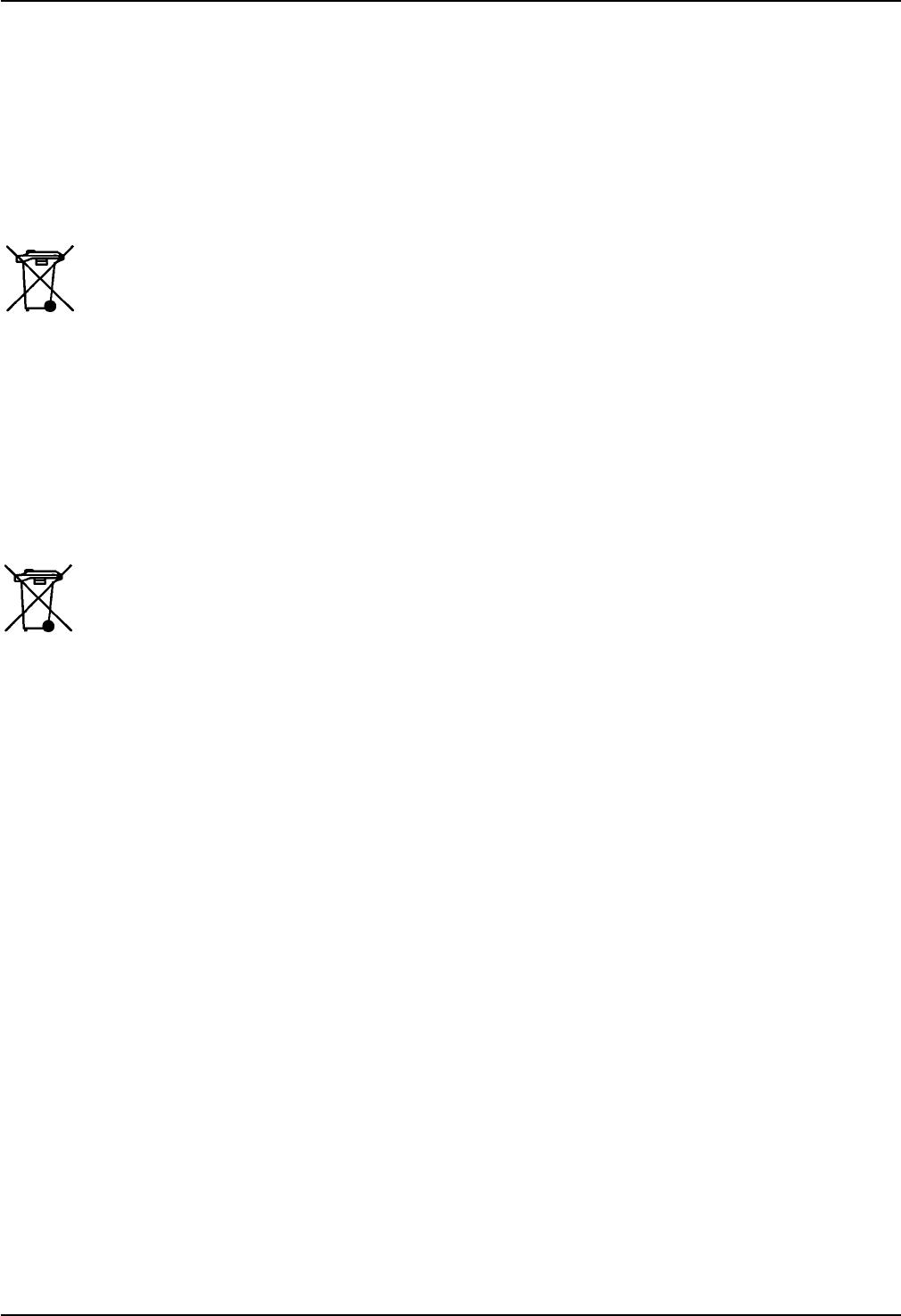
5
z When driving a car, do not use the radio because it may distract you from the other traffic. Never
use a CeoTronics product (headset, insert earphone, induction receiver etc.) that will impair your
hearing.
z Transmit only when it is necessary. Unnecessarily occupying a channel can prevent the transmis-
sion of vitally important information.
z Charge rechargeable batteries only with the appropriate suitable CeoTronics charger. Observe
the voltage and currency specifications, including those on the mains face (e.g. 230 V AC or
115 V AC). Never use the charger to recharge non-rechargeable batteries.
z When handling rechargeable batteries comply with environmental protection regulations! Never
attempt to open a rechargeable battery and never throw a rechargeable battery into fire. Ex-
pended (defective) rechargeable batteries are subject to compulsory regulated waste
disposal. Do not put them in the household waste!
z Ensure that a short-circuit (risk of fire or injury) is not created across rechargeable battery termi-
nals or charging sockets by a short-out (bent-open paper clip, bunch of keys etc.). In such an
event the warranty shall lapse. Transport any spare rechargeable batteries in an electrically non-
conducting package in order to avoid short-circuiting the rechargeable batteries.
z Packaging materials, e.g. filling materials and plastic bags are not toys and have to be kept out of
the reach of children. There is a risk of children ingesting them and choking!
z Safe operation requires clean devices. Ensure that the devices (microphones, connectors etc.)
are clean and in good condition at all times.
z CeoTronics products may only be used for the specific application envisaged.
z Should equipment, supplied by CeoTronics, be definitely put out of service you may return it to
CeoTronics. We ensure recycling and/or disposal of outdated equipment in compliance with
the applicable environment protection law.
z Keep these operating instructions for later use.
2. Description
2.1 Purpose
The CT-DECT Case (see Fig. on the front page) is part of a duplex communication system over short
distances for four or eight mobile participants with CT-DECT Multi Standard (PP). The communication
between the mobile communication participants is wireless. The CT-DECT Case can be furthermore
equipped with a GSM-phone and a two-way radio. The mobile participants can then communicate with
the GSM network and an external two-way radio. The CT-DECT Case is equipped with a socket with
audio output for accessory.
The range between the CT-DECT devices (base/FP and standard/PP) depends on the local circum-
stances. The longest range is reached at eye contact in a free area. Surrounding conditions as moun-
tains, buildings, trees, weather conditions, obstacles (especially the ones containing metal) and body
damping especially with body worn systems may reduce transmitting distance.
Fig. 1 shows a system overview.
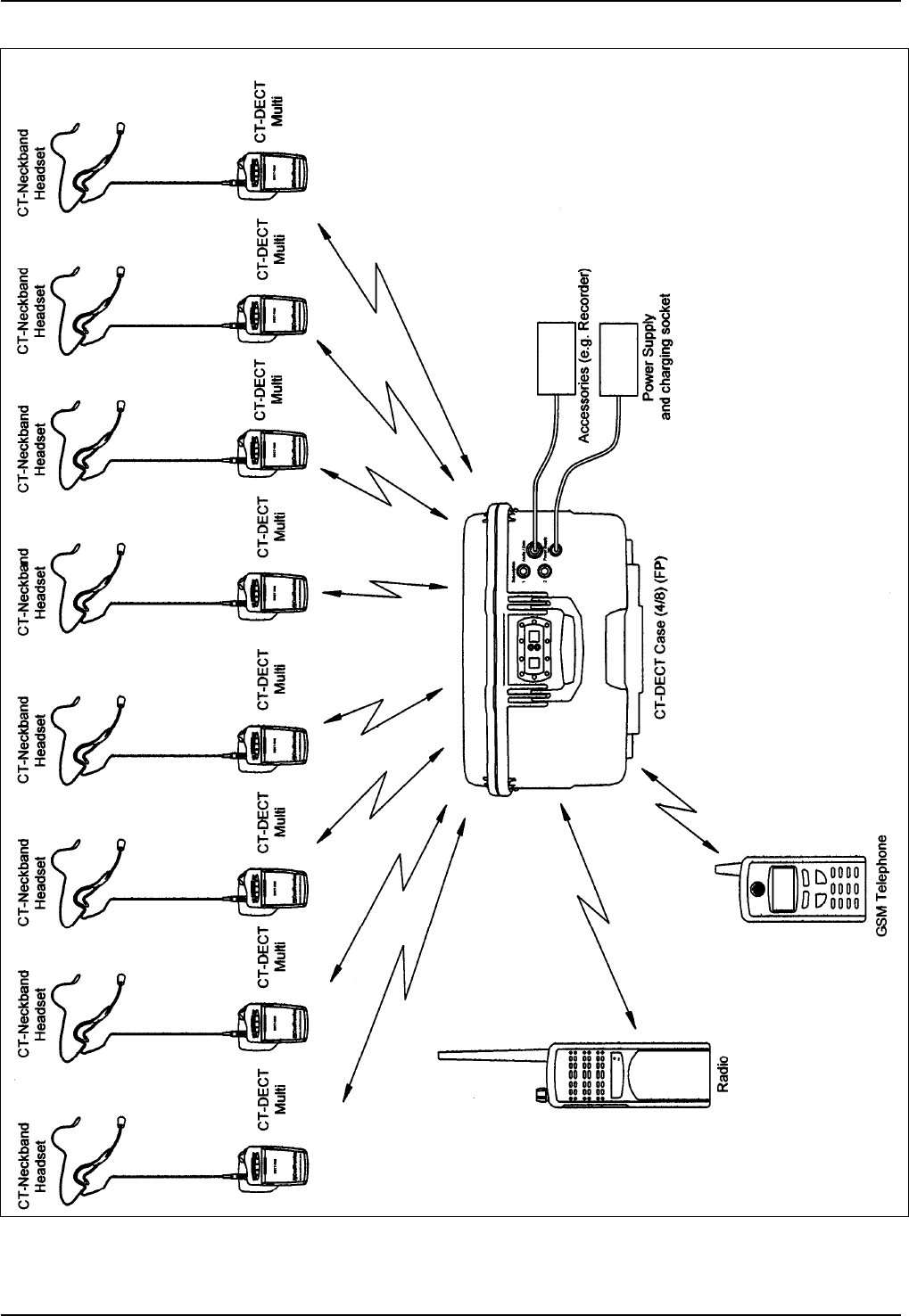
6
Figure 1 System overview (Example)
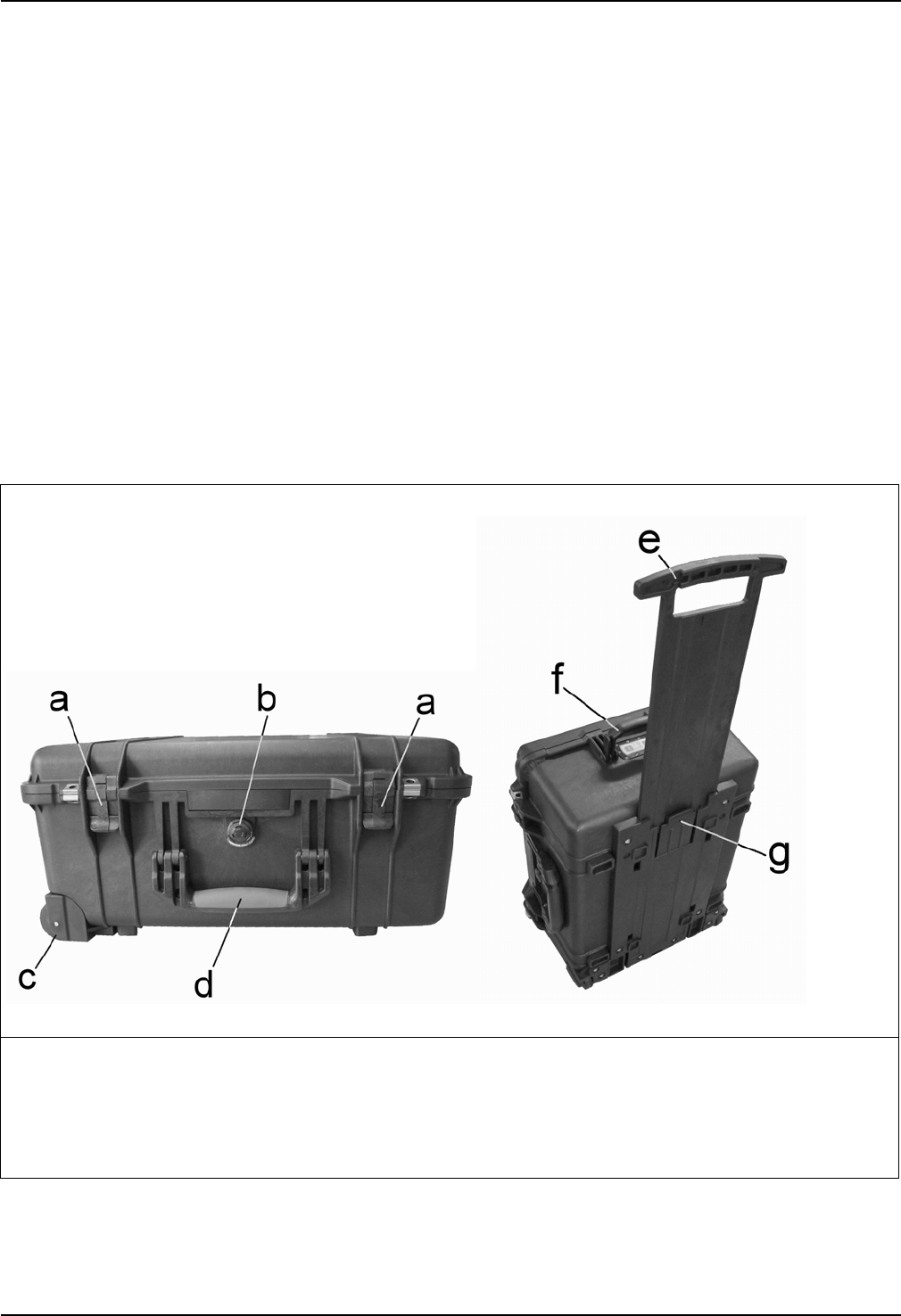
7
2.2 Overview CT-DECT Case
Basic Configuration
- one or two pluggable CT-DECT Conference (4) (FP) (Art. No.1410165; is not included in the scope of
delivery) for each four participants with CT-DECT transmitter-/receiver device standard
- one changeable Power supply with Li-/Ion battery (Art. No.0913024)
- one mains adaptor (Art. No.0913025)
- connector-and control panel at the outside of the CT-DECT Case
The CT-DECT Case is equipped with roles and an extendable handle.
Expandabilities (not included in the scope of delivery)
- GSM-phone
- two-way radio
The CT-DECT Conference (4) (FP) are not include in the scope of delivery of the CT-DECT
Case.
If you equipped the CT-DECT Case with one CT-DECT Conference (4) (FP), the case is useable for the
wireless communication with four mobile participants.
If you equipped the CT-DECT Case with two CT-DECT Conference (4) (FP), the case is useable for the
wireless communication with eight mobile participants.
The installation is described in section 7.1.
Figure 2 CT-DECT Case, closed
a Latch to unlock and lock the CT-DECT
Case
b Automatic purge valve for equalization after
changes in atmospheric pressure
c Rolls
d Hinged handle
e Extendable handle
f Hinged handle
g Lock for extendable handle
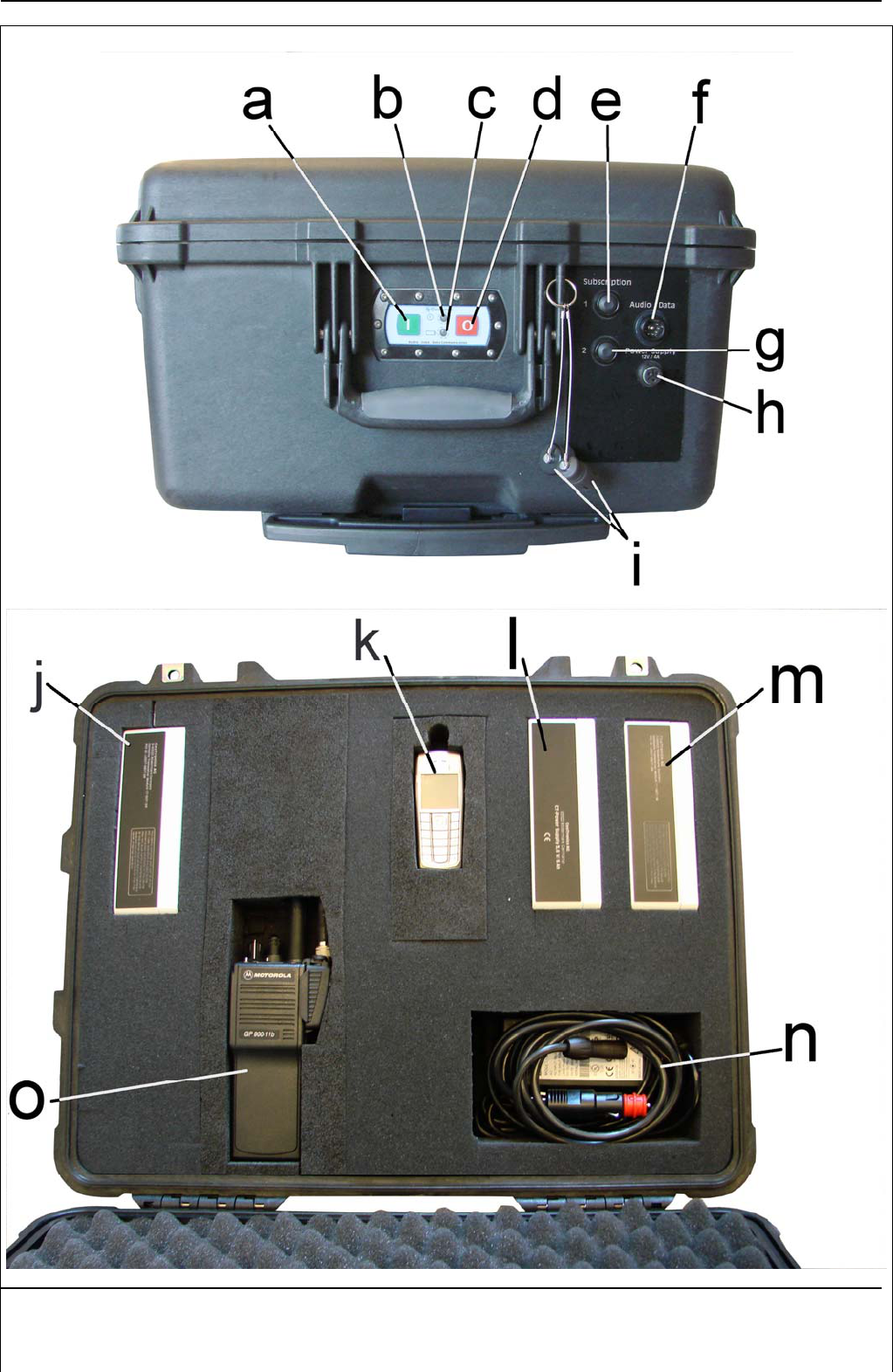
8
Figure 3 CT-DECT Case

9
a Green push button „I“ to switch on the device
b Control lamp, illuminates if the device is swit-
ched on and if the mains adaptor attached
Illuminates green contin. UB > 3,65V
flashes green 1 hour operational
readiness
flashes red 30 minutes opera-
tional readiness
LED off UB ≤ 3,3V, no functi-
on
c Charging / warning lamp
Illuminates red contin. battery is charging
Illuminates green contin. battery full loaded
double flashes red battery is defect
time for charging is
exceeded without
achieving the
necessary power
d Red push button „O“ to switch off the device
e Subscription „1“ button for subscription of
max. four CT-DECT Multi Standard (PP) to
the CT-DECT Conference (4) (FP) „1“
f 9-pin plug for connection of accessory
(e.g. MP3 recorder)
g Subscription „2“ button for subscription of
max. four CT-DECT Multi Standard (PP) to
the CT-DECT Conference (4) (FP) „2“
h 3-pin plug for connecting the mains adaptor
or the Car Mains adaptor
i cover for sockets „f“ and „h“
j CT-DECT Conference (4) (FP) „1“;not part of
the scope of delivery
k GSM-phone; not part of the scope of delivery
l Power Supply with Li-/Ion battery
m CT-DECT Conference (4) (FP) „2“;not part of
the scope of delivery
n Car Mains adaptor and Mains adaptor with
power cord
o Two-way radio (Example), not part of the
scope of delivery
2.3 Description
The CT-DECT Case is the central unit for max. eight mobile CT-DECT Multi Standard (PP).
The CT-DECT Case realizes the following connections:
- wireless duplex-radio connection over short distances between e.g. max. eight CT-DECT Multi Stan-
dard (PP)
- radio connection to an external two-way radio
- GSM connection to the GSM network
A CT-DECT Interface is equipped with one digital transceiver module. One transceiver module can ad-
ministrate max. four CT-DECT Multi Standard (PP). Four CT-DECT Multi Standard (PP) can be as-
signed to one transceiver module. The CT-DECT Multi Standard (PP) must be subscribed at the CT-
DECT Conference (4) (FP).
The CT-DECT Case is equipped with a changeable CT-Power Supply with rechargeable Li-/Ion battery.
It supplied the CT-DECT Case with power. In the CT-Power supply is integrated an battery-/chargering
connection and an power converter 12 V – 3,7 V.

10
3. Commissioning and operation
3.1 Connection of the CT-DECT Case
The Li-/Ion battery in the Power Supply of the CT-DECT Case must be sufficiently charged. Connect
the accessories at the 9-pin socket at the CT-DECT Case, if desired. The 9-pin plug of the connection
cable (Fig. 3/f) has a protection against torsion.
Î NOTE
Keep the CT-DECT Case closed while in use outside!
3.2 Switching on, automatic connection setup, adjusting the speaker volume
Î NOTE
Valid for CT-DECT Multi Standard (PP) which are subscribed to the CT-DECT Case.
a. First switch on the CT-DECT Case with the green pushbutton “I” (Fig. 3/a). The control lamp (Fig.
3/b) illuminates. If the control lamp flashes the voltage of the Li-/Ion battery in the Power Supply is
too low and the Li-/Ion battery has to be charged.
b. Open the CT-DECT Case and switch on the two-way radio. Adjust the right channel in agreement
with the external two-way radio. Consider the user manual of the two-way radio manufacturer.
c. Switch on the GSM-phone. Consider the user manual of the phone manufacturer.
d. Close the CT-DECT Case.
e. Switch on the CT-DECT Multi Standard (PP). Consider for the CT-DECT Multi Standard (PP) the
special CeoTronics operating instructions (Dok 1229).
Subsequently the automatic connection setup between the CT-DECT Multi Standard (PP) and the
CT-DECT Case begins. The time a setup procedure can last is varying. During this time a high/deep
tone sequence every second is audible in the communication sets of the CT-DECT Multi Standard
(PP). When the connection setup is completed the high/deep tone sequence isn't audible any longer.
The CT-DECT Multi Standard (PP) and the CT-DECT Case are now ready for duplex communication
within the range between the CT-DECT Multi Standard (PP) and the CT-DECT Case (8).
f. When receiving speech adjust the speaker volume for your communication set at the CT-DECT Multi
Standard (PP).
3.3 Duplex – communication
After the CT-DECT system is switched on and the automatic connection setup is completed, the max.
eight »mobile« communication participants with CT-DECT Multi Standard (PP) can communicate per-
manently one with each other.
3.4 Radio – communication
The mobile participants with CT-DECT Multi Standard (PP) can communicate via the two-way radio in
the CT-DECT Case with the external two-way radio.
The PTT-criterion of the two-way radio can be remotely controlled by pressing of a PTT-button, inside
the range of the DECT System. The PTT button can be either a PTT button attached at the CT-DECT
Multi Standard (PP), or one of the two outer buttons "PTT" at the push button bank at the CT-DECT
Multi Standard (PP).
Press the PTT button and keep the PTT button pressed. While is pressed the PTT button, you can
send. All mobile participants may listen.
Is no PTT button pressed is radio communication on Standby / Receiving. All mobile participants can
hear an arriving radio message of an external radio. The two-way radio is not part of the scope of deliv-
ery.
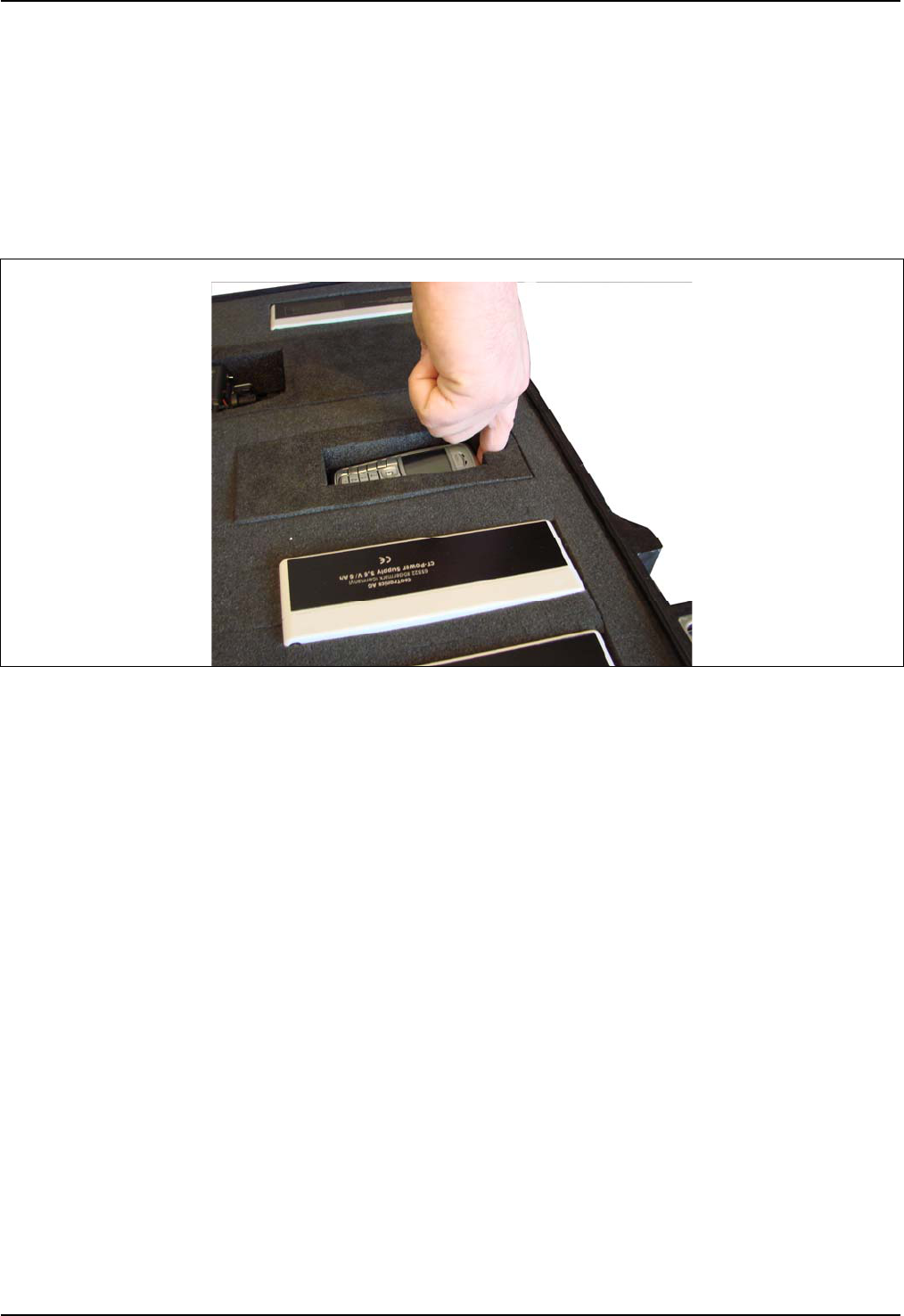
11
3.5 GSM – Communication
The GSM-phone does not have to be taken out for switching on from the case. In the foam pad an
opening is cut out for switching on the GSM-phone (Figure 4). The GSM phone must be equipped with
an automatic call accepted and the call accepted must be switched on. If the GSM-phone in the CT-
DECT Case is called, the call is accepted automatically and all mobile participants in the DECT-System
can talk with the external caller. The external caller can also listen the radio communication via the two-
way radio.
The call can be terminated wireless only by the external caller. The mobile participants in the DECT
system cannot initiate wireless a call to an external phone. The battery of the GSM-phone is loaded
also if loaded the battery of the CT-DECT Case.
Figure 4
3.6 Battery under voltage warning CT-DECT Case
If the voltage of the Li-/Ion battery in the Power Supply is too low, the control lamp (Fig. 3/b) on the out-
side of the case flashes and signalizes that the Li-/Ion battery has to be charged. If the Li-/Ion battery is
discharged furthermore, the power supply is switched off automatically to prevent over-discharging of
the Li-/Ion battery.
4. Safekeeping – storage
Store the cleaned devices in a clean, dry place at normal room temperature and in normal relative air
humidity.
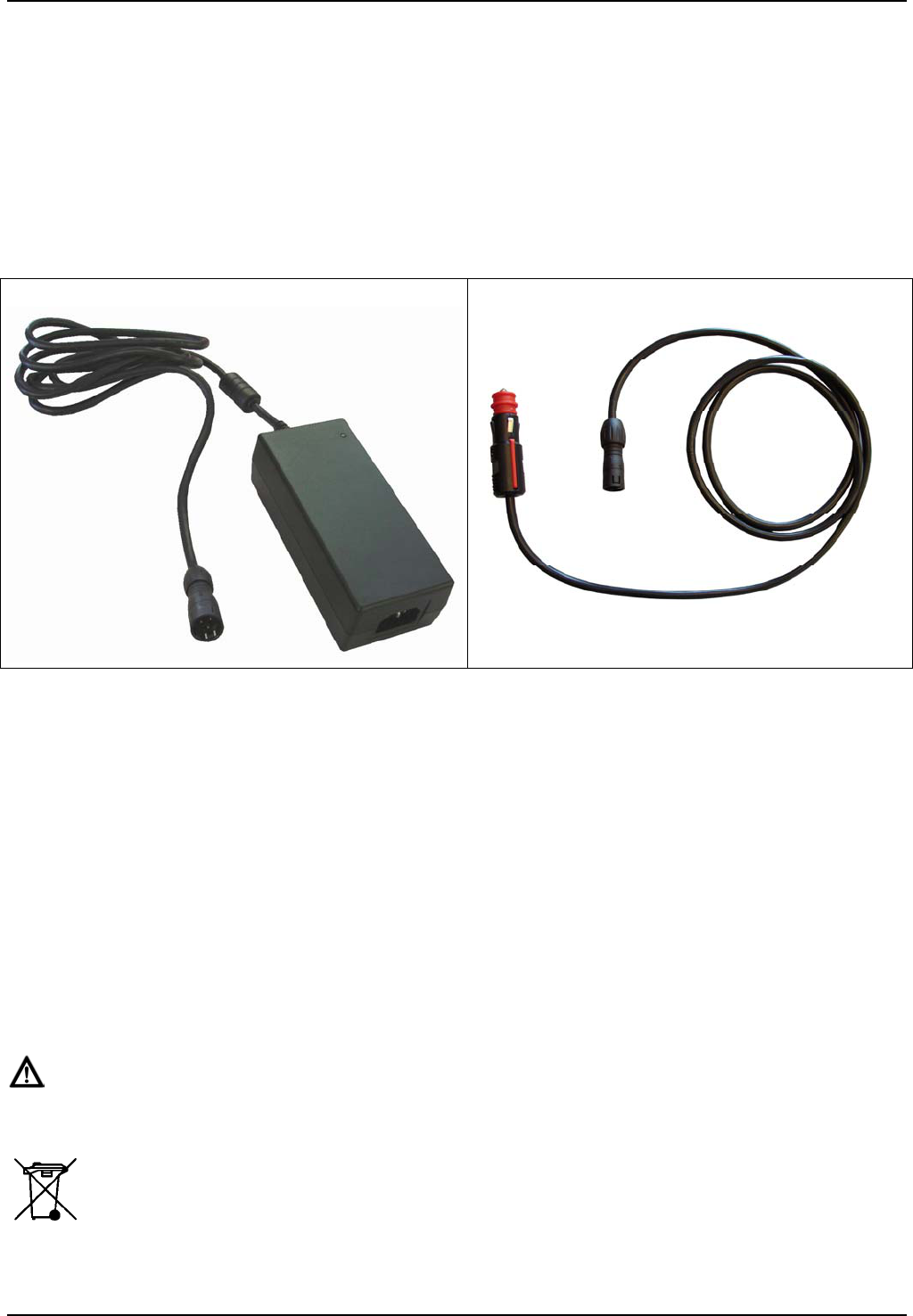
12
5. Charging and changing Power Supply with the
Li-/Ion battery 3.6 V/6 Ah
5.1 General
The mains adaptor supplied the CT-DECT Case with power and the Li-/Ion battery and the battery of
the GSM-phone are charged in the same time. The mains adaptor must be attached to a professionally
installed energized plug socket. The CT-DECT Case can be charged also by the delivered car mains
adaptor (Figure 6) and supplied him with power.
Charging of the batteries takes place only in a temperature range between +3°C and +40°C.
Figure 5 Mains Adaptor for Li-/Ion battery Figure 6 Car Mains Adaptor
Technical specifications and equipment features
– The charge status of the rechargeable battery prior to beginning of the charge is of no significance
– Charging procedure monitored by microcontroller
– Battery test phase at the beginning of each charge to detect totally discharged batteries and to pre-
charge them accordingly
– Detection of rechargeable battery defects and charging current cut-off
– Automatic trickle charge, if the battery voltage drops below a defined value
Use for charging of the Li-/Ion battery in the power supply of the CT-DECT Case only the mains adaptor
or car mains adaptor supplied with the system.
In the case of use of another mains adaptor, battery damage can be the result. The mains adaptor is
neither water nor dust proof, and must be protected against water, rains and contamination. It may be
used only in interior at normal air humidity and normal ambient temperature. Do not cover the ventila-
tion openings.
WARNING
z Never use battery chargers to charge non-rechargeable batteries. Never open rechargeable
batteries or throw them into fire.
z Used (defective) rechargeable batteries are subject to special waste disposal. Do not
put them in the household refuse!
z Never charge a rechargeable battery in areas with an explosion risk – explosion risk.
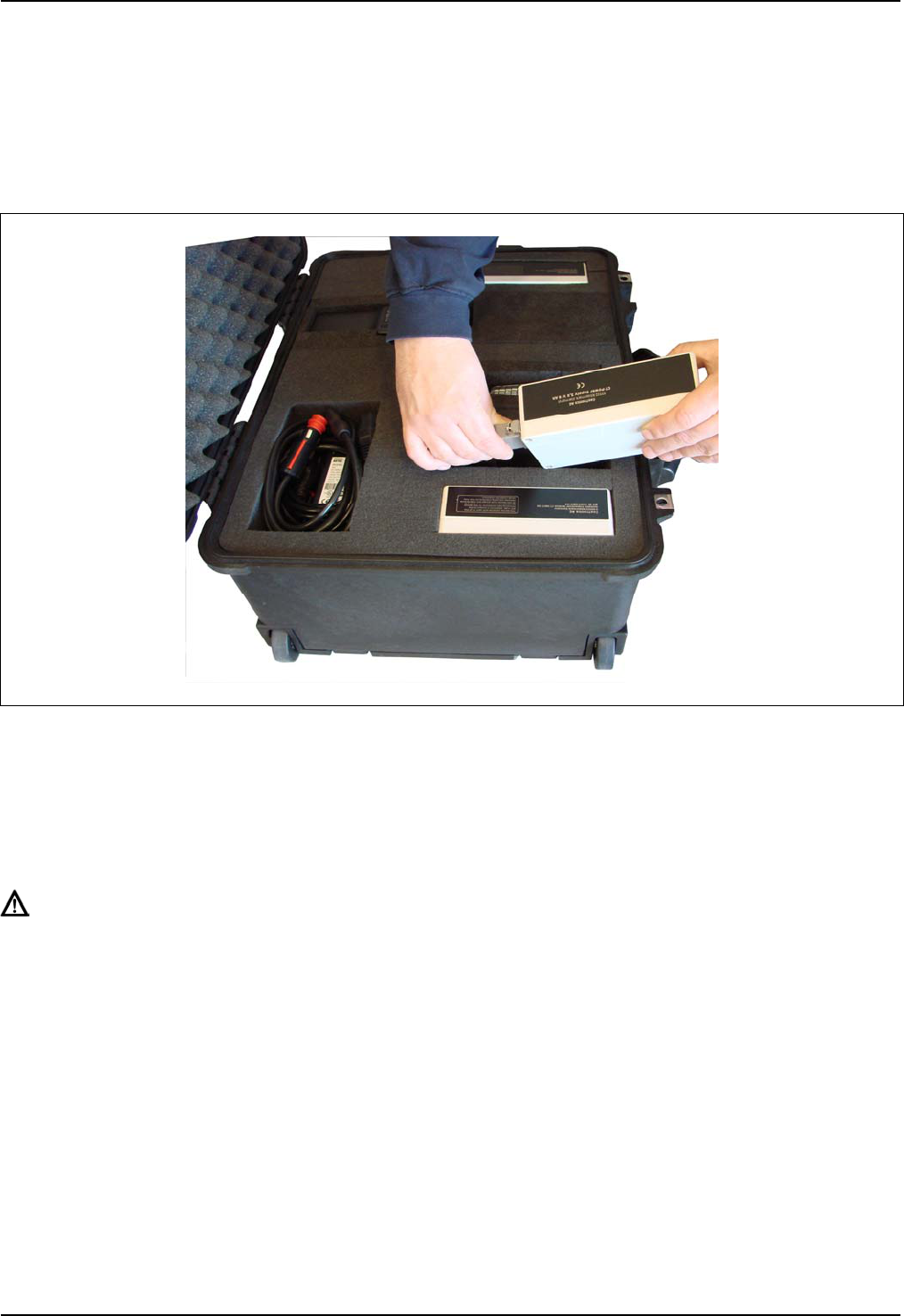
13
Charge and change batteries only in surroundings, where no explosive gasses, steams or
dusts can be available in connection with oxygen.
z Do not charge batteries outside.
5.2 Changing the Power Supply of the CT-DECT Case
Open the cover of the case for changing the power supply. Pull out the Power Supply carefully and
solve the 26-pin plug with help of a screwdriver. Reinstall the new power Supply in reverse order.
Figure 7
6. Maintenance
6.1 Visual inspections
Regularly examine the devices and in particular the cables and connectors for signs of fractures, cracks
and wear. Send defective devices to CeoTronics for repair.
6.2 Cleaning
WARNING
When cleaning ensure that no moisture penetrates inside the device. Do not use any solvents
(e.g. benzine, alcohol, etc.) for cleaning purposes!
Remove any loose dust with a soft brush. Clean, if necessary, the outside of the devices with a suitable
clean cloth that has been slightly moistened with clear water, and rub the parts dry afterwards. If heavily
soiled, some dishwashing liquid can be used in addition.
Clean the contacts of connectors with a commonly available contact cleaning agent.
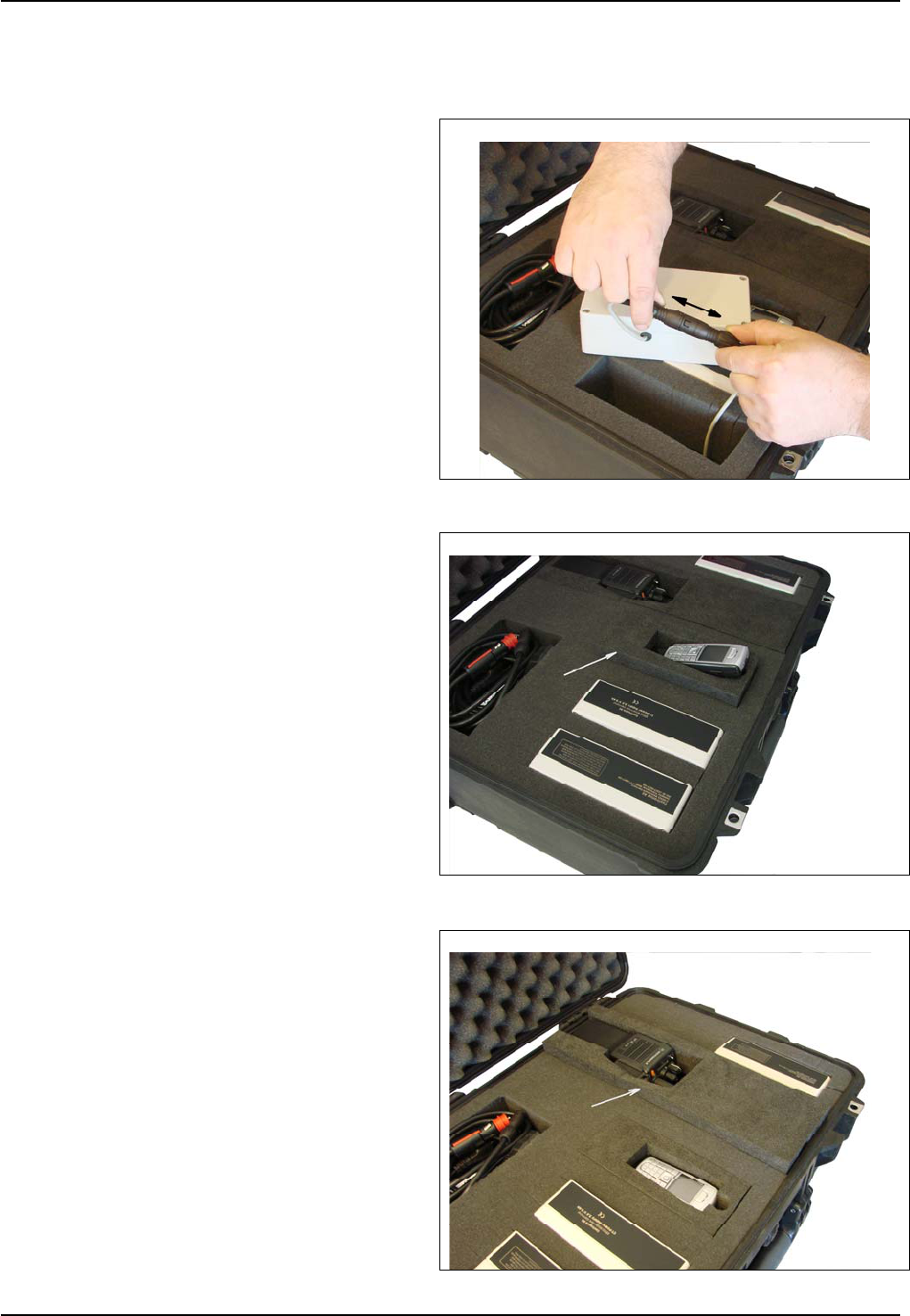
14
7. Installation and Uninstallation of the components CT-DECT Confer-
ence (4) (FP), GSM-phone and Two-way radio
7.1 CT-DECT Interface
Open the cover of the case for changing the CT-
DECT Conference (4) (FP).
Pull out the CT-DECT Conference (4) (FP) „1“ or
„2“ carefully and solve the plug connection.
To open the plug connection pull in direction of
arrow. Do not twist or break the plug connection.
Reinstall the new CT-DECT Conference (4) (FP)
in reverse order.
Make sure during the installation that you place
the plug connection in the storage space under
the CT-DECT Conference (4) (FP).
Figure 8
7.2 GSM-phone
Open the cover of the case for changing the
GSM-phone. Pull out the GSM-phone carefully
and solve the plug connections. The plug con-
nections can be different, depending on phone.
The phone is, depending on design, placed in a
tight-fitting foam adapter (Figure 9, arrow). The
phone can be pulled with the adapter out of the
case.
Pull the phone not to wide from the case, so that
it comes to no damages at the plug connections.
Reinstall the new phone in reverse order.
Figure 9 Example
7.3 Two-way radio
Open the cover of the case for changing the two-
way radio. Pull out the two-way radio carefully
and solve the plug connection. The plug connec-
tions can be different, depending on two-way
radio.
The two-way radio is, depending on design,
placed in a tight-fitting foam adapter (Figure 10,
arrow). The two-way radio can be pulled with the
adapter out of the case.
Pull the two-way radio not to wide from the case,
so that it comes to no damages at the plug con-
nections. Reinstall the new two-way radio in re-
verse order.
Figure 10 Example
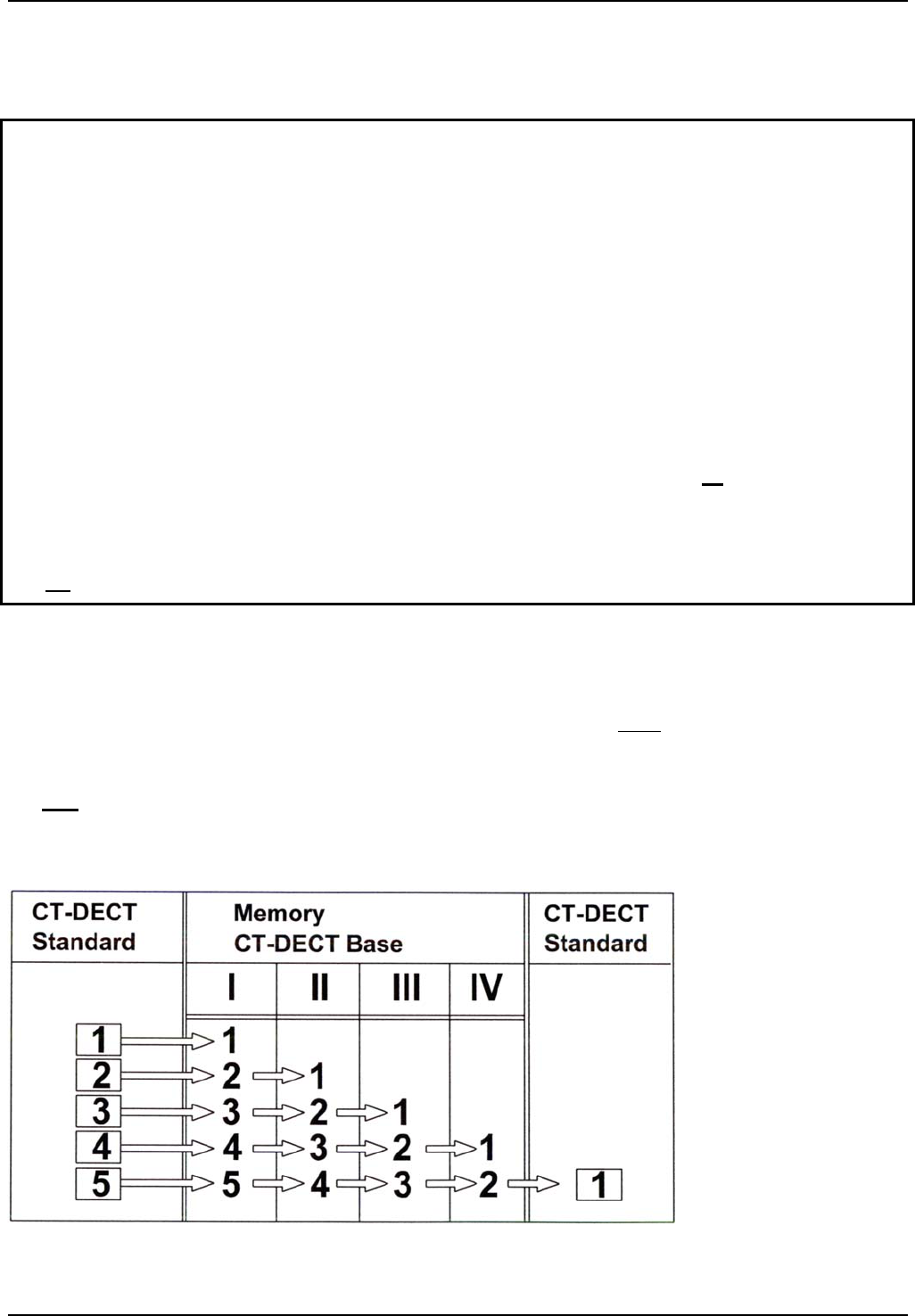
15
8. On-air subscription of CT-DECT Case and
CT-DECT Multi Standard (PP)
8.1 General
Î NOTE
z Subscribing CT-DECT devices standard (PP) into a CT-DECT device base (FP) is usually only
necessary if a CT-DECT system is put into operation for the first time or if individual CT-DECT
devices are replaced, e.g. after repairs.
z A CT-DECT device standard (PP) can only be subscribed into a single CT-DECT devices base
(FP), never into two or more simultaneously.
z Depending on the scope of delivery, it is possible that the CT-DECT devices were already
subscribed appropriately to one another at the QA final inspection at CeoTronics.
In this case you will find a note with the shipment. If there are several CT-DECT device base
(FP), the CT-DECT device are marked in accordance with their assignment to the respective
CT-DECT device base (FP).
z Two CT-DECT devices standard (PP) can never be subscribed simultaneously at a CT-DECT
device base (FP) but always consecutively only.
With several CT-DECT device standard (PP) it is advisable to subscribe all devices in an de-
vice group directly one after the other to the CT-DECT device base (FP), because otherwise
an device may be deleted by mistake (see Section 8.2 »Principle of Subscribing «).
z Keep to the sequence of operating steps.
z All newly subscribed devices must be switched off again after subscription.
8.2 Principle of subscription
Each CT-DECT device is equipped with a DECT module and has its own identification number. First of
all an allocation must always take place between the base device and the maximum of four Standard
(PP) devices. This subscription procedure, which has to be performed once only, is performed on the
base device and the maximum of four Standard (PP) devices manually by means of a procedure car-
ried out by the operator.
If a fifth CT-DECT device standard (PP) would be subscribed to the CT-DECT device base (FP),
the CT-DECT device standard (PP) that was subscribed in first would be deleted from the data
memory of the CT-DECT device base (FP). See the following example.
Principle of subscription (example)
A CT-DECT device standard (PP) that is deleted from the data memory of the CT-DECT device base
(FP) cannot communicate any longer with the CT-DECT system. In this case the CT-DECT device stan-
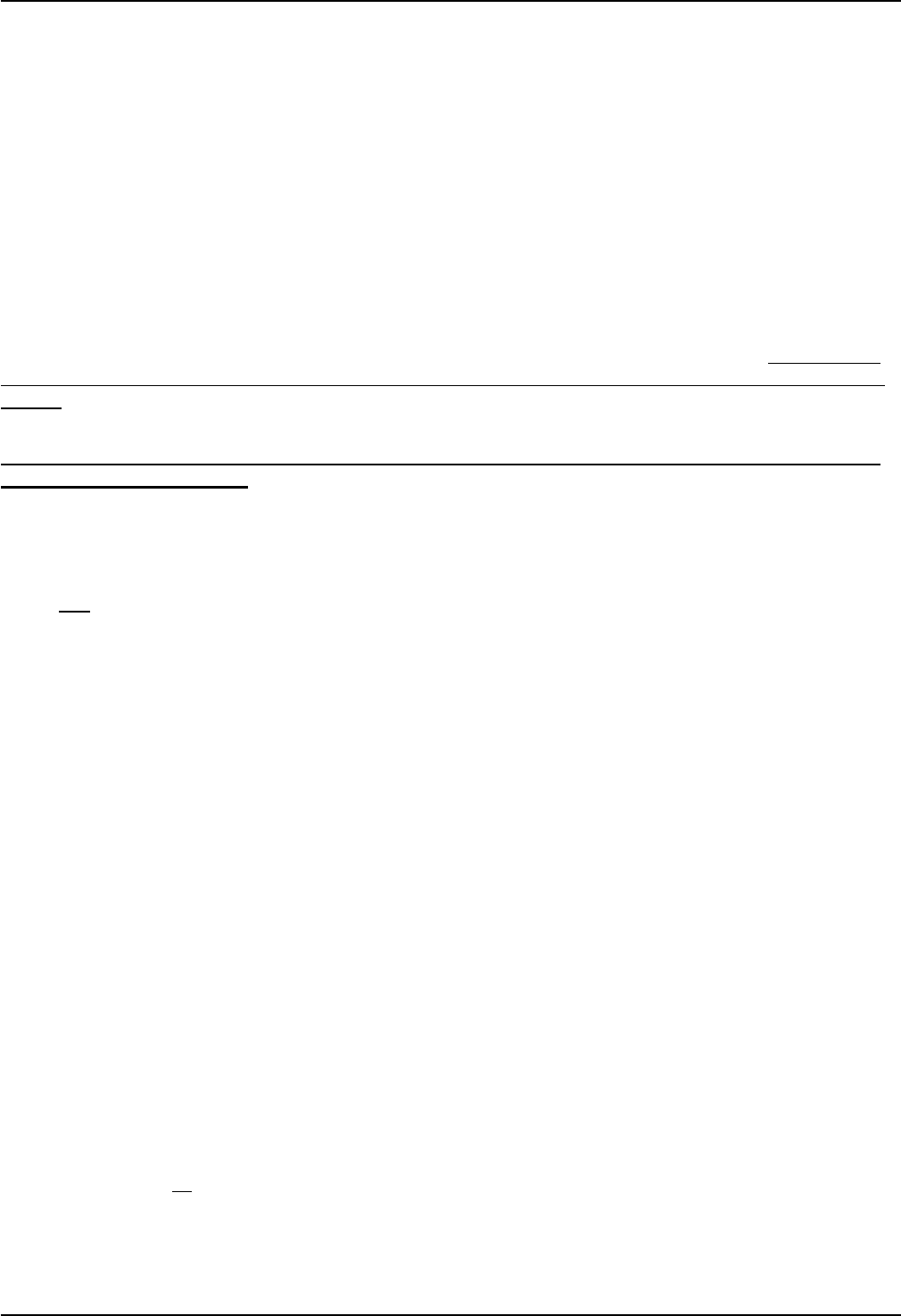
16
dard (PP) has to be subscribed again to the CT-DECT device base (FP) according to the subscription
procedure.
Once the subscription procedure has been successfully concluded, the identity of the communication
participants is stored in the data memory of the device. The CT-DECT device standard (PP) stores one
CT-DECT device base (FP). The CT-DECT device base (FP) stores the last four successful subscribed
CT-DECT devices standard (PP).
8.3 On-air subscription
The on-air subscription procedure is performed on the CT-DECT Case and the CT-DECT Multi Stan-
dard (PP) manually by means of operating elements.
The CT-DECT Case is equipped with up to max. two digital transceiver modules (one in each CT-DECT
Conference (4)).
Each module is allocated a subscription button (Subscription „1“ and „2“) at the outside of the case
(Fig.3). The CT-DECT Case is able to control max. eight CT-DECT Multi Standard (PP). Maximal four
CT-DECT device standard (PP) are allocated in pairs to each transceiver module (= each subscription
button).
The CT-DECT Multi Standard (PP) should be divided into two groups of devices; around errors
when subscribed to avoid:
• Example group 1 – The four CT-DECT Multi Standard (PP) are allocated to subscription button »1«
(Fig. 3/e) at the CT-DECT Case. The subscription of the four CT-DECT Multi Standard (PP) to the
CT-DECT Case is carried out in groups but always one CT-DECT Multi Standard (PP) after the
other.
If a fifth CT-DECT Multi Standard (PP) would be subscribed with the subscription button »1« (Fig.
3/e), the CT-CT-DECT Multi Standard (PP) of group 1 that was subscribed in first would be deleted
from the data base of the CT-DECT Case.
A CT-DECT Multi Standard (PP) that is deleted from the data base of the CT-DECT Case cannot
communicate any longer with the CT-DECT system. In this case the CT-CT-DECT Multi Standard
(PP) has to be subscribed again to the CT-DECT Case according to the subscription procedure.
Principle of subscription see section 8.2
• Example group 2 – The four CT-DECT Multi Standard (PP) are allocated to subscription button »2«
(Fig. 3/g) at the CT-DECT Case.
In the case that the CT-DECT Case is equipped only with one CT-DECT Conference (4) is only
the subscription button »1« active.
In the case that the CT-DECT Case is equipped with two CT-DECT Conference (4) are both sub-
scription buttons active.
Î Note
For the CT-DECT Multi Standard (PP) of the group 2 the subscription procedure is same like the
subscription procedure for the CT-DECT Multi Standard (PP) of group 1. The subscription pro-
cedure for the CT-DECT devices standard (PP) is described in sections 8.4...8.4.2.
Time Out
If no successful subscription was achieved after maximally 2 minutes, a »Time Out« occurs. The »Time
Out« is signalized by a tone sequence of 4 short deep tones in the CT-DECT communication set, which
repeats itself every 4 seconds.
After a »Time Out« all CT-DECT Multi Standard (PP) of a group have to be subscribed again to the CT-
DECT Case. With a single CT-DECT Multi Standard (PP) only this single device has to be subscribed
again.

17
8.4 On-air subscription CT-DECT devices standard of group 1
In the following by way of an example the subscription of the max. four CT-DECT Multi Standard (PP)
of group 1 to the CT-DECT Case is described.
8.4.1 On-air subscription of the first CT-DECT Multi Standard (PP) of group 1
a. Ensure that the CT-DECT Multi Standard (PP) switched off and the CT-DECT Case is switched on.
b. Prepare the first CT-DECT Multi Standard (PP) for the operation, leave it however switched off. Con-
sider the special CeoTronics operating instructions of the CT-DECT Multi Standard (PP).
c. At the CT-DECT Case press the subscription button »1« (Fig. 3/e) and keep it min. 5 sec. pressed.
Then release the subscription button. Immediately carry out step »d«, otherwise a »Time Out« may
occur.
d. At the first CT-DECT Multi Standard (PP) press the subscription button and keep the subscription
button pressed. While you keep the subscription button pressed switch on the CT-DECT Multi Stan-
dard (PP) and after switching on keep the subscription button still pressed for at least 5 seconds until
a descending 5-tone sequence is audible in the communication set. Then release the subscription
button.
The subscription is started and in the communication set a short high beep tone is audible periodi-
cally every 2 seconds. An increasing 5-tone sequence - which repeats itself every 4 seconds - sig-
nalize that the subscription has been successful completed.
If no successful subscription was achieved after maximally 2 minutes, then this is signalized by a to-
ne sequence of 4 short deep tones, which repeats itself every 4 seconds.
Then switch off the CT-DECT Multi Standard (PP) and restart the subscription procedure.
e. After the successful on-air subscription switch off again the subscribed first CT-DECT Multi
Standard (PP).
The subscription procedure of the other three CT-DECT Multi Standard (PP) is the same like for
the first device.
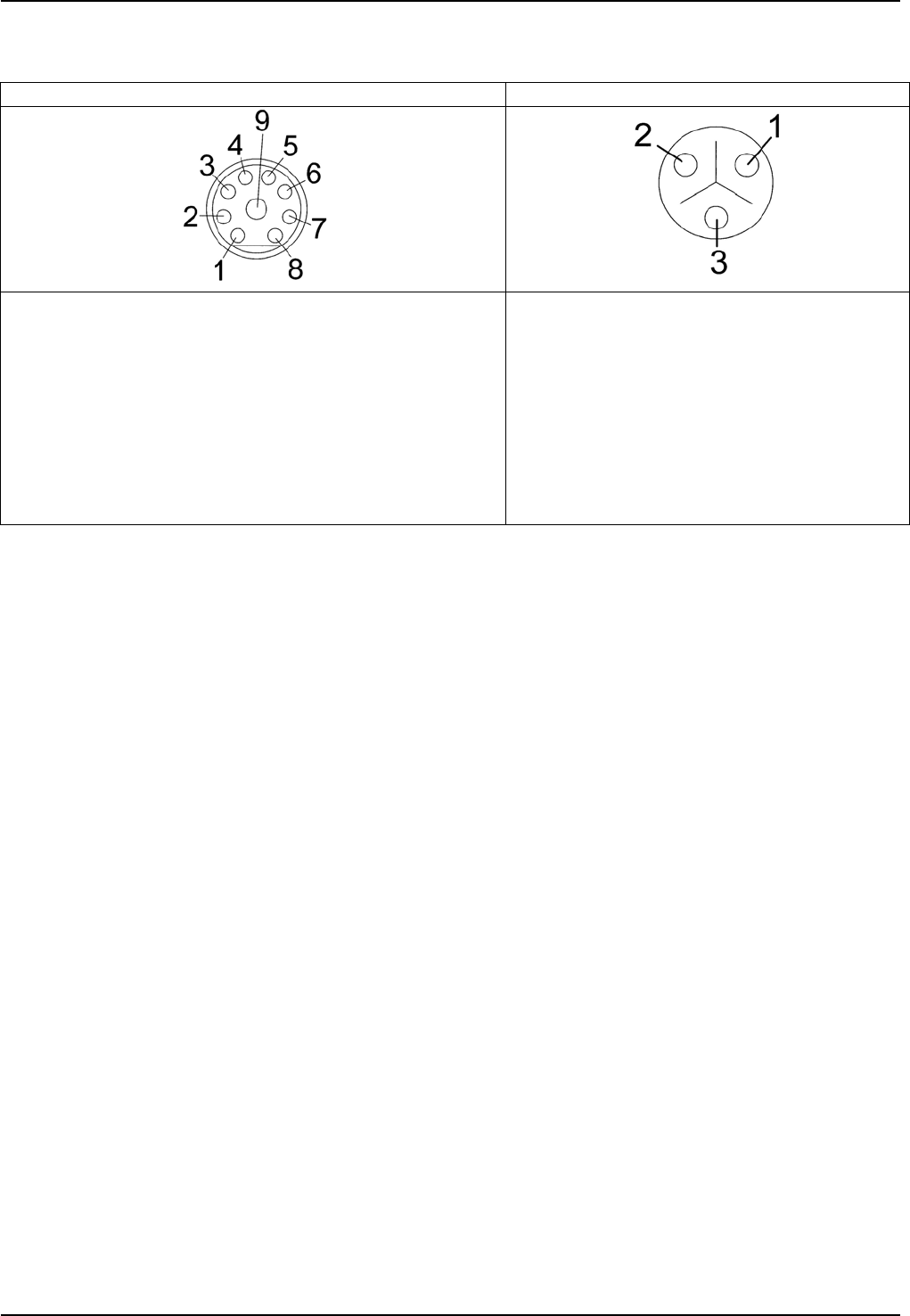
18
9. Technical Specifications
Socket assignment:
Socket Audio/Data socket Power Supply
1 IF_IN1 -200mV/600
Ω
2 IF_IN2 -200mV/600
Ω
3 IF_OUT1 -200mV/600
Ω
4 IF_OUT2 -200mV/600
Ω
5 MP -GPIO-Port active “1”
6 IN+ -Power supply input
7 N.C
8 Battery+ -Power supply for ext.
accessory (I<100mA)
9 IN- -GND
1 + -12V
2 - -GND
3 RES

19
Notes
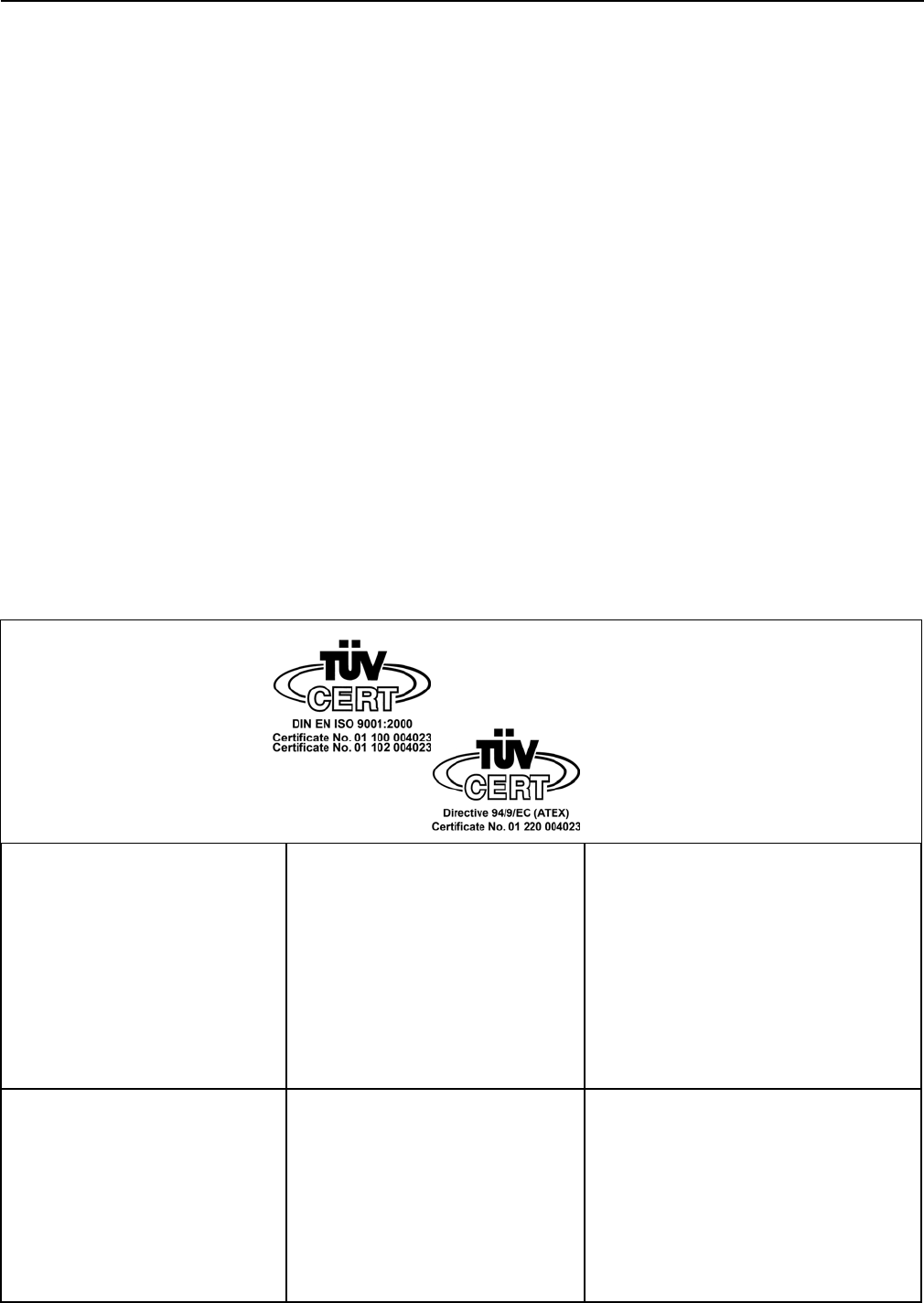
Germany and
International Sales
CeoTronics AG
Adam-Opel-Str. 6
63322 Rödermark
Tel. +49 6074 8751-0
Fax +49 6074 8751-676
E-Mail sales@ceotronics.com
USA/Canada/Mexico
CeoTronics, Inc.
300 Southport Circle, Suite 103
Virginia Beach, Virginia 23452
Tel. +1 757 549-6220
Fax +1 757 549-6240
E-Mail sales@ceotronicsusa.com
France
CeoTronics Sarl
Bât. Delta T
Z.A. du Tuboeuf
Allée des Pleus
77257 Brie Comte Robert Cédex
Tel. +33 1 60183300
Fax +33 1 60286060
E-Mail ventes@ceotronics.fr
Spain
CeoTronics S.L.
C/Ciudad de Frias 7 y 9
Nave 19
28021 Madrid
Tel. +34 91 4608250 51
Fax +34 91 4603193
E-Mail ventas@ceotronics.es
Switzerland
CeoTronics AG
Grundstr. 16
6343 Rotkreuz
Tel. +41 41 7905838
Fax +41 41 7905839
E-Mail info@ceotronics.ch
Poland
CeoTronics Sp. z o.o.
ul. Słonecza 15
91-491 Łódź (Polska)
Tel. +48 42 6553311
Fax +48 42 6552288
E-Mail biuro@ceotronics.pl
Germany and
International Sales
CT-Video GmbH
Gewerbegebiet Rothenschirmbach 9
06295 Lutherstadt Eisleben
Tel. +49 34776 6149-0
Fax +49 34776 6149-11
E-Mail ctv.info@ceotronics.com
EIGENE/CT-DECT Case/dok1267-be.doc/01/1208 y DOK 1267 Änderungen vorbehalten
Copyright © 02/2007 CeoTronics AG, 63322 Rödermark, Deutschland, Internet www.ceotronics.com